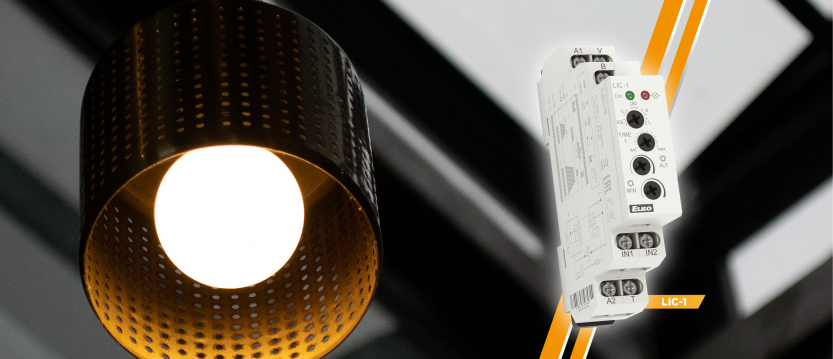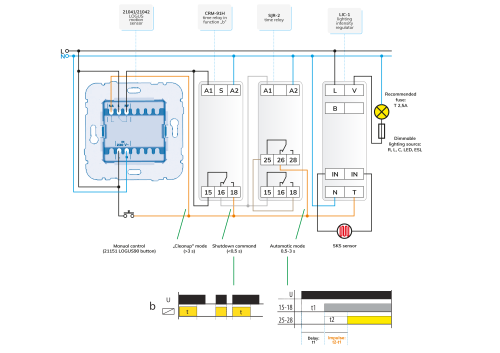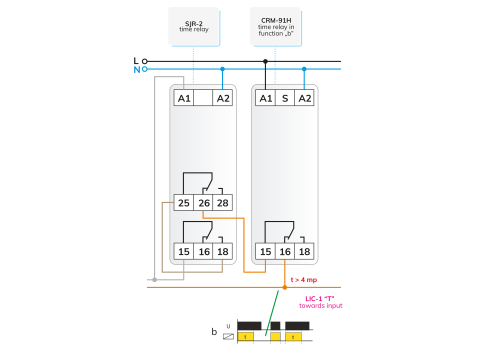
+1 (312)439-2098
- Home
- Solutions
- Commercial Buildings
- Automatic Lighting Control with LIC-1
Automatic Lighting Control with LIC-1

The LIC-1 is an automatic lighting controller designed to maintain a consistent illumination level in a monitored space. By adjusting its output in response to changing ambient light, the device ensures stable lighting—lowering artificial lighting when sunlight increases and raising it as daylight fades.
This makes the LIC-1 ideal for environments like offices or workspaces with large windows, where maintaining consistent lighting throughout the day improves comfort and visibility. The device uses an external light sensor (SKS accessory) and supports various types of 230 V AC light sources, including resistive (R), inductive (L), capacitive (C), LED, and ESL lamps.
Operating Modes of the LIC-1
The LIC-1 has three configurable operating modes, selected using a pushbutton connected to its “T” input:
- Short press (< 0.5 sec): Switches the output off. This also occurs automatically on power-up.
- Medium press (0.5 – 3 sec): Switches to automatic mode. (Only works if the output was previously turned off.)
- Long press (> 3 sec): Switches to cleaning mode, which sets the output to 100% illumination.
Automating the Automation
This functionality is especially useful in areas requiring constant background lighting for safety or orientation—such as footpaths, corridors, or cycle tracks. In such cases, the LIC-1 can keep illumination at a low level during inactive periods, then switch to 100% brightness when motion is detected.
Each luminaire along the path can operate independently with its own LIC-1 and motion sensor. When no motion is present, the controller dims or switches off the light based on ambient lighting. When movement is detected, it switches the output to full brightness. After the sensor’s timer expires, the LIC-1 returns to its prior state (typically automatic mode), conserving energy.
With proper configuration, the light is never fully disabled for long. Even during the day, LIC-1 will limit output to zero if natural light is sufficient—eliminating unnecessary consumption.

How the Circuit Works
On Power-Up:
- LIC-1 starts switched off.
- CRM-91H receives power via the NC (normally closed) contact of the motion detector.
- The CRM-91H outputs a 0.5-second off pulse, but since LIC-1 is already off, it has no effect.
- After the CRM-91H pulse ends, SJR-2 receives power via another NC contact, beginning its delay.
- The “T” input of LIC-1 receives an approx. 2-second pulse, switching it to automatic mode.
On Motion Detection:
- Motion triggers the sensor relay, sending a >3-second pulse to the LIC-1 “T” input.
- LIC-1 responds by setting its output to 100% (cleaning mode).
- Once the motion timer expires, the sensor returns to rest, supplying power to the CRM-91H again.
- CRM-91H sends a 0.5-second off pulse, switching off LIC-1.
- SJR-2 follows with a delayed pulse (0.5–3 sec), switching LIC-1 back to automatic mode.
Manual Override:
A manual pushbutton on the “T” input is recommended, allowing the user to force any mode (Off / Auto / 100%) when needed.
Additional Options
The circuit can be further customized based on the application:
- Timed operation with real-time schedules: Use a digital time switch like SHT-1/230V to schedule periods of automatic operation.
- Delay auto-switch to automatic mode at startup: Use a CRM-91H time relay in function “b” to block the automatic-mode pulse for approx. 4 seconds after startup. This ensures LIC-1 stays off after power restoration until motion is detected.
Once the motion sensor is triggered post-delay, the automation sequence begins as normal. This secondary delay circuit is only active immediately after powering on.

Energy Efficiency & Practical Use
As days get longer and natural light increases, LIC-1 helps reduce energy usage by scaling down artificial lighting automatically. In addition to comfort, this can result in substantial cost savings over time.
Consider where you might benefit from using the LIC-1—whether as a standalone controller or combined with motion detection for adaptive lighting.
Final Notes
The circuit designs in this article are principle-level examples intended to inspire practical applications. Not all configurations have been live-tested. It is essential to review the technical details before implementation and adapt them to suit your specific conditions.
If you’ve improved or adjusted a solution, feel free to share it—we’d be glad to pass it on to other readers.
Didn't find what you were looking for?
Tech Support
+1 (312) 439-2098
techsupport@elkoepna.com
Customer Support
+1 (251) 284-6636
elkosupport@elkoepna.com
General Contact
+1 (608)746-1332
info@elkoepna.com
Headquarters
1150 NW 72nd Ave, Tower I,
Suite 455 #9226, Miami, FL 33126